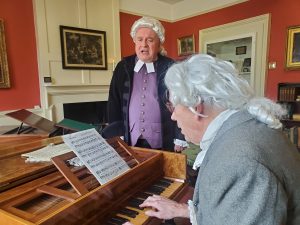We discuss here the materials and design of a straw-work box dating from the late eighteenth or early nineteenth century. It belonged to the Reverend John Newton, Curate of St Peter and St. Paul Church, Olney from 1764 to 1779.
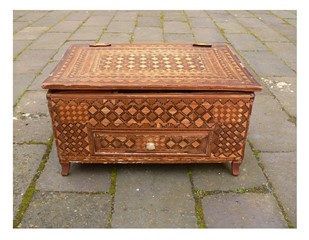
The box – an overview
The box is a good example of Napoleonic prisoner-of-war straw marquetry work. It is a typical product and has the typical ‘look’ of this highly skilled craft.
In some respects the box is very crudely made. For example, the construction methods (mostly cutting and sticking) and materials (wood, straw and bone) were cheap and easily found. This simplicity in approach is hardly surprising if we bear in mind that it was produced under prison conditions. But the overlaid decorative finish – the straw work – is highly intricate, and would have taken considerable time and skill to achieve.
Newton’s box may have been made to hold trinkets, though other very similar boxes were used to hold gaming counters and cards.
Newton’s box
We do not know for sure how Newton acquired his box. It came to the museum through his family who believed that Newton bought it on one of his infamous voyages to the West Indies in the 1750s.
It is much more likely that Newton bought the box here in the UK during the Napoleonic Wars, possibly as a present for his wife Polly. He was an avid prison visitor and regularly attended London prisons, both to preach and to convert. To ease overcrowding in gaols some old ships were moored in the River Thames and used as prisons. Newton might easily have included these in his evangelical visits.

He is also known to have visited the prison ships or ‘hulks’ at Southampton with his niece. Either here, or at nearby Portsmouth where the old naval ship HMS York was anchored and used as a gaol, Newton would have had ample opportunity to see and choose his trinket box. (It is also possible that the box could have been acquired from one of the land-based POW camps, such as Norman Cross, near Peterborough – see below.)
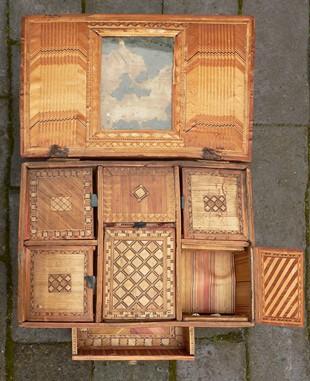
The basic framework
The body and legs of the box are made of pine. This is a readily available soft wood, easily cut into thin sheets ready for assembly into the basic rectangle required for many boxes such as this one. The lid has been attached with two broad hinges made of leather, rather roughly pinned to the back of the box on the outside, rather than discreetly hidden away within the decoration. But if we feel around a bit at the back of the box, behind the pinning, we come across traces of a metal disc tucked inside the straw overlay. The hinges on many prisoner-of-war boxes were made of circular pieces of cheap metal; bent to support the required opening and shutting action and then fixed to the wood with glue. It seems likely that the original hinges of our box were of this sort, but they have either rusted away or been otherwise broken. Leather replacements are quite common in fact, and often nearly as old as the originals: metal is a brittle material and not ideal for constant bending.
The inside of the box is in two layers. The top layer is divided into six small compartments, each separated from the other by straw-decorated wooden ‘walls’ and with its individual lid. The lids are held in place with a narrow strip of woven fabric. This has been glued on and, due to its flexibility, also acts as a hinge. A tag of black ribbon, also glued to each lid, serves as a lifting device.
The lower layer is fitted with a small central drawer with a small, carved, oval handle made of bone.
The straw work
The straw work covers the entire box. Each surface, inside and out, apart from the base, has been decorated in a sumptuous variety of geometric patterns.
The box maker has used an overlay technique called marquetry. This was a much practised and admired woodwork technique used by European cabinet makers (usually Dutch, German or French) in the seventeenth century to embellish their furniture. These craftsmen used narrow strips of different coloured and grained wood veneers to create rich patterns and pictures. These were cut, arranged and then glued closely into position to make an impressive, smooth, patterned finish.
Our box follows in this tradition but the makers have used lengths of straw rather than wood veneers to decorate the surface. The use of straw instead of wood is usually said to have begun in France and Holland, but the practice was introduced to England as early as the seventeenth century. By the middle of the eighteenth century English makers were decorating various kinds of boxes in this way; most notably working on tea caddies. These were expensive items, made to hold an expensive commodity, and tended to be more sturdily built than the prisoner-of -war box we are looking at here. For example, they would have had more professional hinges, and probably a good lock too.
Napoleonic prisoners of war
During the period of the Napoleonic wars, from the 1790s to 1815, Britain shipped thousands of men into England as prisoners. They were encamped all over the country at various large sites, perhaps most notably at Norman Cross, near Peterborough. This camp was custom-built in 1797 and used as a POW camp (or ‘depot’) until 1814.
The men were encouraged to make themselves useful during their imprisonment and to eke out their meagre rations by making and selling their handcrafted objects.
Straw, bones, pieces of wood or metal, bits of string and fragments of glass, all such scraps were used and turned into what are now collectors’ items. Boxes, cigar cases, apple corers, needlework tools, all sorts of small and large objects were turned out. Bone ships, with perfect rigging made by knowing sailors, are particularly fine examples. Sailors were also experienced plaiters and twiners; these skills, learned from ropemaking, were applied to various kinds of straw product, such as hats and bonnets as well as to the famous laid straw marquetry.
The tools used were wrought from nails, wire, bolts and other such scrap metal; the glues came from boiled-down beef and mutton bones.
Preparing and applying the straw
Straw is a by-product of arable farming – the dried stalks of cereals, such as oats, barley, rye and wheat. Over time, craftsmen salvaged these stalks and used them in various creative ways. They made three-dimensional pieces – such as corn
dollies, brooches and other personal accessories – as well as flat embellishments like the work we see on Newton’s box, or thin plaited braids that might be sewn or woven into other structures.
The preparation involved differs, according to whether it is to be used for three-dimensional or flat work. Three-dimensional crafts require dampened whole pieces of straw to work with, while for laid straw work, selected stalks need to be split lengthways, opened out and then flattened. Through this process, stiff hollow stems can be readily turned into narrow, flexible ‘ribbons’. These can then be cut into shapes, or further split into narrower straight lengths, depending on the planned design.
Straw comes in many natural shades of gold and brown, sometimes darkening even to black, and these formed the straw worker’s basic palette. Designers spent time selecting and assembling pieces so as to exploit these natural variations in colour and tone. The insides and outsides of stalks vary in their reflective qualities too (the outsides naturally shinier that the insides) and this property also contributes to particular visual effects. A designer who played carefully with each of these ingredients could incorporate a remarkable range of perceptual tricks, as well as have fun mixing and matching and essentially organising and re-organising our visual experiences.
But designers could do more: they would quite commonly include other colours, predominantly dyes of green, orange and pink, to add extra richness and to increase their patterning options. These added colours were not light-fast however and faded easily; and they also wore away with use. So, the outsides of boxes and other P.O.W. straw work may look rather dull and lacking in sparkle or colour today – but open the drawer of a box, or lift a lid, and the visual effects can startle; where the straw has neither dulled with use nor faded through light exposure it can really shimmer and glow!
Once the straw ribbons had been cut and shaped, they were often assembled and stuck to paper, piece-meal fashion, before the final work was glued in place. This allowed the designer to build up patterns carefully but also, if this was their preferred creative method, to let ideas develop and grow organically. This stage-by-stage assembly process also introduced a certain element of mass production: rows of material, in one pattern (say, alternating dark and light squares or diamonds), might be cut into shorter lengths, turned and angled and stuck onto paper to form another, more complex pattern (perhaps a chequerboard, or stripes or a trellis). These more complex patterns might, in their turn, be cut, and sections of them turned or angled and re-arranged into blocks of another geometric pattern, all this before the final gluing into position.
The patterning potential of naturally coloured lengths of straw is pretty remarkable, but introduce an extra colour or two and the possible permutations are enormous.
The patterns on Newton’s box
The marquetry designs used in European POW straw work vary a good deal, but common to the tradition are pictorial scenes, stylised flowers, images of birds, ships, or buildings and, most typically, geometric work.
Newton’s box is a remarkable feat of geometric patterning. On the lid alone there are at least nine distinctive pattern areas. Although it is hard to name all of these variations in pattern it is fascinating to try and analyse some of the structures.
The central trellis
At the very centre of the lid there is a large rectangle of trellis work. This is surrounded by eight or nine (depending how we divide things up visually) different edging patterns. But let us look more closely at the ways this visual idea, that of an organised whole with a central motif, is built up.

If we start with the rectangular central trellis, how is this achieved and why do we see it as a central motif? One way of thinking about this is to take an imaginary journey with the pattern maker and consider how he might have built up his effects from scratch.
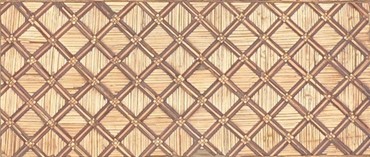
The trellis pattern is constructed from rows of zig-zags which, when combined, become rows of diamonds. Once we mentally re-define two single rows of zigzags as one row of diamonds, the initial, ‘zaggy’ filling of blond-coloured straw, at the top, perhaps looks rather unfinished. But what happens next? The whole process is repeated but in alternating fashion. The maker assembles two rows of zigzags again but starts differently. So his ‘ziggy ups’ become ‘ziggy downs’, and his fillings change from dark to pale straw again. As a result one more row of diamonds emerges, but these blond diamonds have shifted one space along the line.
If we step back from the design process for a moment here, and switch our attention to look up, rather than across each row, these new diamonds have a second alignment: they begin to suggest an arrangement of blond columns as well as blond rows. This is because the horizontally laid slivers of pale straw in these diamonds reciprocate visually with the very first pale ‘zag’ fillings we noted in Row One.
Things get more and more perceptually complex as this basic formula is repeated. Single lines of zigzags become doubled; they become, in our perception, single lines of diamonds; then the idea of single rows of diamonds competes with that of single columns of diamonds; and finally both these notions get swallowed up by an even larger unitary concept – that of a trellis. At this juncture we have again switched our visual understanding of the patterning and now read our initial short zigzag lines as longer unifying diagonals.
Pattern recognition is a giddy-making process of mind changing when looked at this way. But it seems there are two basic elements involved in pattern making and reading – framing and filling. These two perceptual steps guide the way we gain our sense of an ordered space and of a recognisable design. Here we have a framework of black lines (actually doubled black lines each with a paler filling!) ultimately ‘making’ diamonds that have been filled with pale or dark straw. While framing defines and gives initial form, when this form is filled a pattern gains in substance and interest.
Notice especially the tiny patterned decorations added at each cross-over point of the trellis we have been examining. How do these work visually? They are probably there to highlight the overall shape that is being formed at the centre of the lid; that is, they emphasise the hierarchy of lines and spaces and encourage us to see a trellis rather than mere rows or columns of diamonds, or, less likely still, mere zigzags. Much is achieved through visual nuances such as these, though we are usually unconscious of them.
The trellis edgings
It would be wearing to insist on going through all the pattern formations that surround this trellis in similar detail. Suffice it to say that the edgings all work as frames to the central motif. They emphasise it so that it is hard to argue against the visual idea of a central trellis. They establish a ‘field of force’. (An effect sometimes exploited by interior designers to celebrate or highlight some particularly valuable or expensive bit of work. A centrally placed, magnificent Tudor fireplace framed and thus emphasised by pillars, a mantel and carved panelling, might be a classic example.)
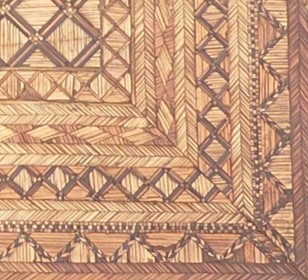
The patterned edgings on Newton’s box include more diamonds, more zigzags, and some neat herring-bone and chequer-board effects. The applied shreds of straw in these patterns are carefully chosen to vary in colour, tone and heaviness so as to achieve distinctions that might be otherwise unobserved.
A particularly nice effect is achieved with the chequer-board filling to some of the larger zigzags (discrete lines here, no diamonds) on both the lid and the front of the box. Indeed it is worth remembering that the designer was probably having fun as he played with permutations of alignment and colour. Pattern making is usually more about visual exuberance, adventure and discovery than perceptual experimentation.
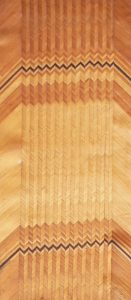
Inside the box
We cannot leave ideas of joyous patterning before looking at the inside of this box. The orangey pinks and yellows used here glow; the patterns and variations of pattern multiply and astound. Stripes, diagonals, arrows, chequer boards, spots and dots all compete for attention. Perhaps most striking of all – and to my eye most modern – are the two panels each side of the mirror set into the lid. Long, thin, minimalist lines, coolly elegant pale stripes, attend the centre of these panels, whose third dimension is brilliantly highlighted, top and bottom, with a single row of black zigzags, while below these the pale, central verticals continue as darker stripes. The effect is reminiscent of some of the powerful Art Deco ornament at 78 Derngate, Northampton, that is to say, of a Charles Rennie Mackintosh interior design.
Further reading
Chamberlain, Paul, Hell upon Water – Prisoners of War in Britain 1793-1815, The History Press, 2008
Chamberlain, Paul, The Napoleonic Prison of Norman Cross, The History Press, 2018.
Croucher, Lina, Straw Mosaics, Reeves Dryad Press, 1975
Choain-Degand, Anne-Marie, Marqueterie de Paille, VIAL, 2019


